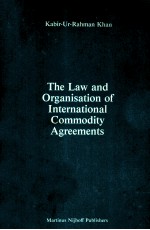图书介绍
The law and organisation of international commodity agreementsPDF|Epub|txt|kindle电子书版本网盘下载

- Khan 著
- 出版社: M. Nijhoff ;
- ISBN:9024725542
- 出版时间:1982
- 标注页数:416页
- 文件大小:18MB
- 文件页数:437页
- 主题词:
PDF下载
下载说明
The law and organisation of international commodity agreementsPDF格式电子书版下载
下载的文件为RAR压缩包。需要使用解压软件进行解压得到PDF格式图书。建议使用BT下载工具Free Download Manager进行下载,简称FDM(免费,没有广告,支持多平台)。本站资源全部打包为BT种子。所以需要使用专业的BT下载软件进行下载。如BitComet qBittorrent uTorrent等BT下载工具。迅雷目前由于本站不是热门资源。不推荐使用!后期资源热门了。安装了迅雷也可以迅雷进行下载!
(文件页数 要大于 标注页数,上中下等多册电子书除外)
注意:本站所有压缩包均有解压码: 点击下载压缩包解压工具
图书目录
INTRODUCTION1
1. Perspective1
2. Scope5
3. Approach6
CHAPTER ONE PRINCIPLES OF INTERNATIONAL ECONOMIC LAW AND INTERNATIONAL COMMODITY ORGANISATIONS9
1.1 Introduction9
1.1.1. Elements of International Commodity Agreements9
1.1.2. Regulation10
1.1.3. Operation12
1.1.4. Organisation13
1.2. Principles15
1.2.1. Negotiation15
1.2.1.1. Freedom of Commerce15
1.2.1.2. Economic Sovereignty17
1.2.1.2.1. Regulation of Exports20
1.2.1.2.2. Prices21
1.2.1.2.3. Research and Development21
1.2.1.2.4. Producers'Associations22
1.2.1.3. State Responsibility23
1.2.1.3.1. Reasonable Price24
1.2.1.3.2. Fair to Consumers24
1.2.1.3.3. Co-operation from Importing Countries25
1.2.1.4. Most-Favoured-Nation Treatment25
1.2.1.4.1. Pre-GATT Phase25
1.2.1.4.2. Post-GATT Phase31
1.2.2. Regulation34
1.2.2.1. Equitable Treatment34
1.2.2.2. Reciprocity36
1.2.2.3. Economic Proportionality37
1.2.2.4. Non-Discriminatory Treatment of Third Parties38
1.2.2.5. Principle of Good Neighbourliness39
1.2.3. Organisation40
1.2.3.1. State Participation40
1.2.3.2. Open Membership41
1.2.3.3. Parity of Votes among Exporting and Importing Countries42
1.2.3.4. Distributed Majority42
1.2.3.5. Internal Settlement of Disputes42
CHAPTER TWO DEVELOPMENT OF INTERNATIONAL COMMODITY POLICY52
2.1 The Anglo-Dutch Phase: National Interest52
2.1.1. Rubber53
2.1.2. Tin53
2.1.3. United States'Response54
2.1.4. Principles of Organisation55
2.2. The League Phase: Global Emergency55
2.2.1. Covenant of the League of Nations55
2.2.2. Economic Rationalisation56
2.2.3. World Monetary and Economic Conference 193357
2.2.3.1. Rationale57
2.2.3.2. Principles58
2.2.3.3. Commodities Discussed at the Conference59
2.2.3.4. Application of the Principles60
2.2.3.4.1. At the Conference60
2.2.3.4.2. After the Conference61
2.2.3.4.3. Agreements: Wheat and Sugar61
2.2.3.4.4. Consumers' Representation65
2.2.3.4.5. League of Nations Committee for the Study of the Problems of Raw Materials65
2.3. The Havana Phase: Special Difficulties of Individual Commodities66
2.3.1. Scope67
2.3.2. Rationale68
2.3.3. Principles70
2.3.4. Practice71
2.3.5. Evaluation73
2.4.The UNCTAD Phase: ICAs Instruments of Economic Development74
2.4.1. New International Economic Order: Integrated Programme74
2.4.2. Salient Features75
CHAPTER THREE INTERNATIONAL QUOTA SYSTEM81
3.1. Introduction81
3.2. Purposes and Objectives83
PART I87
3.3. Organisation of Instruments and Measures87
3.3.1. Regulation of Exports87
3.3.1.1. Basic Export Entitlements87
3.3.1.2. Determination of Agreement Market91
3.3.1.3. Allocation of Agreement Market92
3.3.1.4. Maintenance of Agreement Market93
3.3.1.4.1. Exports in Excess of Entitlement93
3.3.1.4.2. Special Arrangements95
3.3.1.4.3. Non-Commercial Exports96
3.3.1.4.4. Imports from Non-Members97
3.3.1.4.5. Production in Importing Countries98
3.3.2. Regulation of Stocks99
3.3.2.1. Maximum Stocks99
3.3.2.2. Minimum Stocks100
3.3.2.3. Special Stocks100
3.3.2.4. International Stock101
3.3.3. Regulation of Production102
3.3.4. Measures related to Demand and Consumption104
3.3.5. Adjustment of Prices106
3.4. Operation of the Quota System108
3.4.1. Price108
3.4.1.1. Minimum Price109
3.4.1.2. Maximum Price112
3.4.1.3. Stabilisation of Prices114
3.4.1.4. Increased Export Earnings117
3.4.2. Access to Market117
3.4.3. Assurance of Supplies117
3.4.3.1. Defensive118
3.4.3.2. Substantive118
PART II129
3.5. Working of Agreements129
3.5.1. Sugar129
3.5.1.1. Paris Convention 1864130
3.5.1.2. Brussels Convention 1902130
3.5.1.3. International Sugar Agreement 1937133
3.5.1.4. Contemporary Sugar Agreements137
3.5.2. Coffee142
3.5.3. Cocoa149
CHAPTER FOUR INTERNATIONAL STOCK SYSTEM157
4.1. Introduction157
4.2. Development158
4.2.1. The Tin Pool Agreement 1931158
4.2.2. Negotiation for a New Agreement161
4.2.3. The Tin Buffer Stock Agreement 1934163
4.2.4. The Tin Buffer Stock Agreement 1938166
4.2.5. Summary167
4.3. Contemporary Phase168
4.3.1. Salient features168
4.3.2. Organisation of Stock169
4.3.2.1. Contribution170
4.3.2.2. Size170
4.3.2.3. Form172
4.3.2.4. Functions173
4.3.3. Export Control175
4.3.4. Limitation on Stocks during Control Periods178
4.3.5. Price Range and Adjustment178
4.3.6. Disposal of non-commercial stocks by participating members181
4.3.7. Measures to Deal with Tin Shortage182
4.3.8. Supplies from Non-Members183
4.3.8.1. USSR183
4.3.8.2. USA185
4.3.9. Working of ITA and Evaluation189
4.3.9.1. ITA I: 1956-1961189
4.3.9.2. ITA II: 1961-1966191
4.3.9.3. ITA III: 1966-1971191
4.3.9.4. ITA IV: 1971-1976193
4.3.9.5. ITA V: 1976-1981194
4.3.9.6. Evaluation194
CHAPTER FIVE MULTILATERAL CONTRACT SYSTEM211
5.1. Development211
5.1.1. International Wheat Agreement 1933213
5.1.2. The Washington Conference 1941-42216
5.2. Multilateral Contract System221
5.2.1. The 1949-1958 Phase222
5.2.1.1. Principles222
5.2.1.2. Administration224
5.2.1.2.1. Price224
5.2.1.2.2. Carrying Charges225
5.2.1.2.3. Adjustment in Guaranteed Sales and Purchases226
5.2.1.2.4. Recording of Transactions227
5.2.1.3. The 1953 and 1956 Agreements227
5.2.2. The 1959-1971 Phase228
5.2.3. Evaluation234
CHAPTER SIX NIEO INTEGRATED PROGRAMME FOR COMMODITIES: ELEMENTS NEGOTIATIONS AND PROSPECTS245
6.1. New International Economic Order245
6.1.1. Legal Significance245
6.1.2. Integrated Programme for Commodities249
6.1.2.1. Structure250
6.1.2.2. Common Fund254
6.1.2.2.1. Scope and Operation256
6.1.2.2.1.1. International Stocks256
6.1.2.2.1.2. Quasi-International Stocks258
6.1.2.2.1.3. Research and Development259
6.1.2.2.2. Resources262
6.1.2.2.3. Organisation263
6.1.2.2.4. Conclusions265
6.1.3. IPC Negotiations265
6.1.3.1. Food Commodities266
6.1.3.1.1. Bananas266
6.1.3.1.2. Meat270
6.1.3.1.3. Tea273
6.1.3.1.4. Vegetable Oils276
6.1.3.1.4.1. International Olive Oil Agreement 1979278
CHAPTER SEVEN INTEGRATED PROGRAMME FOR COMMODITIES: CONTINUED289
7.1.3.2. Agricultural Raw Materials289
7.1.3.2.1. Cotton and Cotton Yarns289
7.1.3.2.2. Hard Fibres and Hard Fibre Products293
7.1.3.2.3. Jute and Jute Products300
7.1.3.2.4. Rubber304
7.1.3.2.4.1. International Natural Rubber Agreement 1979309
7.1.3.2.5. Tropical Timber318
7.1.3.3. Metals and Minerals321
7.1.3.3.1. Bauxite321
7.1.3.3.2. Copper323
7.1.3.3.3. Iron Ore326
7.1.3.3.4. Manganese328
7.1.3.3.5. Phosphate329
7.1.4. Conclusions331
CHAPTER EIGHT INTERNATIONAL COMMODITY ORGANISATION: TREATY AND INSTITUTIONAL ASPECTS343
8.1. Treaty Aspects343
8.1.1. Form343
8.1.2. Coming into Force344
8.1.3. Duration347
8.1.4. Amendment350
8.1.5. Reservation351
8.2. Institutional Aspects353
8.2.1. Membership353
8.2.1.1. Governments353
8.2.1.2. Group Membership356
8.2.1.3. EEC and other Regional Organisations357
8.2.2. Termination359
8.2.2.1. By Decisions of Members359
8.2.2.2. By Decisions of Commodity Organisation361
8.2.3. Organs362
8.2.3.1. The Council363
8.2.3.2. Selective Organ364
8.2.3.3. Administrative Organ367
8.2.3.4. Budget367
8.2.3.5. Privileges and Immunities367
8.2.4. Decision-Making Process371
8.2.5. Settlement of Disputes373
SUMMARY AND CONCLUSIONS387
BIBLIOGRAPHY395
INDEX OF NAMES401
INDEX OF SUBJECTS403